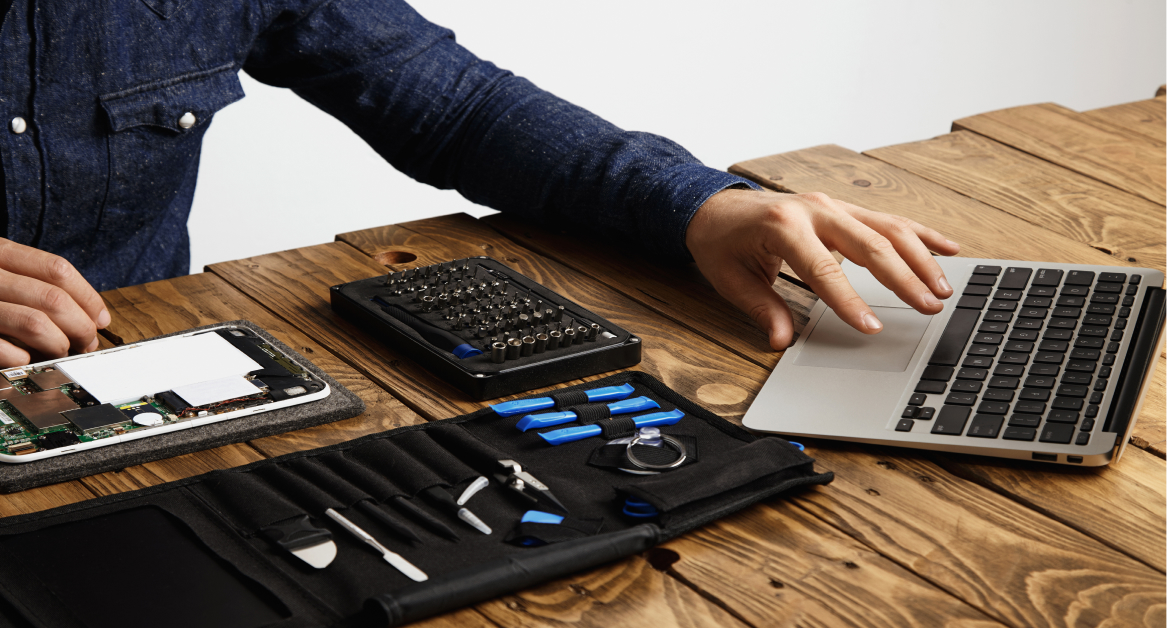In today’s fast-paced digital world, IT teams need flexible and cost-effective ways to manage their devices. Two popular options are device as a service (DaaS) and leasing. While both approaches involve acquiring hardware over time, they serve different needs and offer distinct advantages. Understanding the key differences can help your business choose the right model to support growth, optimize cash flow, and stay up-to-date with the latest technology.
Whether you’re looking to minimize upfront costs or ensure seamless device lifecycle management, knowing when to opt for DaaS or leasing can significantly impact your IT strategy. Let’s explore both options to help you make an informed decision that aligns with your business goals.
Understanding DaaS
Device as a service (DaaS) is a subscription-based model that delivers IT equipment—including laptops, tablets, and smartphones—along with ongoing management and support. Instead of making a large capital expenditure (CapEx) to buy devices outright, companies pay a predictable monthly fee to access the latest technology and comprehensive services.
One of the biggest benefits of the DaaS model is flexibility. Companies can easily scale up or down their device fleet based on changing needs, which is especially valuable for businesses with remote or hybrid teams. With DaaS and leasing, organizations gain access to the latest technology without the hassle of managing hardware refresh cycles.
A typical DaaS offering includes device procurement, device lifecycle management, automatic updates, security, technical support, and device de-provisioning when employees leave or switch roles. This complete package not only simplifies device management but also ensures that employees always work on secure, up-to-date equipment—an essential factor in today’s security-conscious landscape.
Exploring leasing
Leasing is a traditional way for businesses to acquire devices without paying the full upfront cost. Under a leasing model, companies agree to rent hardware—such as computers, tablets, or smartphones—over a fixed period, typically ranging from two to five years. Instead of purchasing, a business pays a monthly fee that covers the use of the device for the duration of the lease.
Leasing models offer several advantages. The most significant benefit is the fixed-term structure, which helps organizations plan their expenses with certainty. This constant monthly payment simplifies budgeting and cash flow management. Additionally, leasing often includes maintenance and repair services, reducing unforeseen costs and ensuring that devices remain operational throughout their lifecycle.
Unlike the DaaS model, leasing doesn’t always include comprehensive device management or security features—you’re primarily paying for access to the device itself. However, some leasing agreements now offer upgrades or exit options that allow businesses to refresh their hardware before the lease expires, ensuring access to newer technology without making a large upfront investment.
Leasing can be especially appealing for companies that prefer predictable expenses or need to manage budget constraints tightly. It’s also a stable solution for organizations that want to spread costs over several years without worrying about the complexity of device ownership and lifecycle management.
While leasing models have been around for decades, they continue to evolve. Today, many leasing agreements are hybrid, combining aspects of traditional leasing with newer offerings like device as a service, giving companies more flexibility to align device procurement with their unique needs.
Key differences between DaaS and leasing
While both DaaS and leasing involve acquiring devices without an immediate large upfront cost, they serve different purposes and offer distinct advantages. Understanding these key differences can help your organization decide which model best suits your needs.
1. Flexibility and scalability
- DaaS: Designed for flexibility. You can easily scale your device fleet up or down, typically with a pay-as-you-go monthly fee. It’s ideal for dynamic environments or growing teams.
- Leasing: More rigid, with fixed terms and limited ability to adjust during the lease period. Early upgrades may incur penalties or require new agreements.
2. Device management and support
- DaaS: Comes with comprehensive device lifecycle management, automatic updates, security patches, and technical support included in the subscription. It’s a full-service solution that simplifies IT operations.
- Leasing: Usually only provides access to hardware, with optional maintenance plans. You are responsible for managing updates, security, and support unless
3. Costs and payments
- DaaS: Operates on a subscription-based model with a monthly fee that covers hardware, support, security, and management services. It turns CapEx into OpEx, improving cash flow and simplifying budgeting.
- Leasing: Also involves regular payments, but primarily focuses on hardware rental. It may save on initial costs, but can sometimes result in higher total costs over the lease term, depending on terms.
4. Access to the latest technology
- DaaS: Provides continuous access to the latest technology. Companies can refresh devices regularly—often annually—ensuring employees always have up-to-date equipment.
- Leasing: Usually offers a fixed term, after which businesses might need to lease new devices. Upgrades depend on lease terms and may require negotiations.
5. Management responsibilities
- DaaS: The provider handles device provisioning, management, security, and support, making it a hands-off, all-in-one solution.
- Leasing: The company typically manages these aspects internally or through separate service providers, which can increase workload.
6. Device lifecycle management
- DaaS: Comes with end-to-end management, including de-provisioning and recycling or redeploying outdated devices.
- Leasing: Focuses mainly on device use during the lease; managing lifecycle beyond that is usually on the company’s shoulders.
When to choose DaaS
Deciding between DaaS and leasing depends on your company’s unique needs, growth plans, and resource capabilities. Here are some scenarios where opting for DaaS can be particularly advantageous:
Rapidly growing or changing workforce
If your company is expanding quickly or frequently onboarding new employees, a DaaS model offers unmatched flexibility. You can scale device provisioning up or down easily, ensuring your team always has the right hardware without the hassle of renegotiating lease terms or managing large upfront purchases.
Need for the latest technology
Organizations that prioritize access to cutting-edge devices should lean toward DaaS. With its subscription-based model, you can refresh your hardware annually or at desired intervals, keeping your team equipped with the latest technology for productivity and security. This approach supports a competitive edge, especially in industries like tech, design, or finance.
Focus on device lifecycle management
If managing the whole lifecycle of your devices—provisioning, maintenance, security, and decommissioning—sounds overwhelming, DaaS is the ideal solution. It provides a comprehensive platform that streamlines these processes, freeing your IT team to focus on strategic initiatives.
Optimizing cash flow and budgeting
For startups or businesses looking to convert capital expenditure into operational expenditure, DaaS offers predictable monthly payments. This allows better cash flow management, reduces large upfront costs, and simplifies budgeting.
Security and compliance priorities
Companies handling sensitive data or operating in regulated industries benefit from DaaS’s integrated security features and automated updates. These ensure devices remain compliant and protected, reducing the risk of breaches.
Supporting a remote or distributed workforce
With employees spread across various locations, centralized device management becomes critical. DaaS solutions simplify onboarding, support, and device de-provisioning remotely, maintaining security and efficiency across global teams.
Examples of successful DaaS adoption
These include companies in technology, finance, and global consulting firms that operate in dynamic environments. They have reported streamlined device management, reduced downtime, and better security posture—all achieved by leveraging the flexibility and comprehensive services offered by DaaS.
When leasing might be better
While DaaS offers numerous advantages for modern, flexible IT management, there are scenarios where leasing remains a practical and effective choice:
Stable, mature business operations
If your business has a steady, predictable workflow and doesn’t expect rapid growth or frequent staffing changes, leasing can provide a simple, straightforward solution. It’s ideal for companies that prefer fixed costs over time and want to avoid the potentially higher monthly payments associated with some DaaS offerings.
Longer-term device planning
Leasing is often suitable when you want a device for an extended period—say, three to five years—without the need for frequent upgrades. Many organizations prefer to keep devices longer to maximize their investment, especially when on a tight budget or operating in industries with slower technology turnover.
Limited internal IT resources
Some organizations with small or less experienced IT teams may prefer leasing because it requires less ongoing management. Leasing providers may offer maintenance and support options, but in general, it leaves the device lifecycle management largely in the company’s hands.
Cost control and budget predictability
Leasing models with fixed monthly payments can help organizations manage cash flow efficiently over the long term. For businesses that prioritize budget stability and de-risking cost fluctuations, leasing offers a predictable expense structure.
Existing Infrastructure and Processes
If your company already has established processes around device procurement and lifecycle management, leasing models might integrate more seamlessly. It could be more practical and cost-effective compared to switching to a full-service daas solution.
Industry or regulatory constraints
Some industries or government agencies have regulations that favor ownership of hardware or specific leasing arrangements with predefined terms, making leasing the more compliant or strategic choice.
Expert insight
Industry specialists suggest that leasing works best for companies with predictable device needs and no urgent requirement for frequent updates. It allows them to spread out costs and keep control over their device lifecycle.
Case example
A manufacturing firm with stable operational technology might lease its devices for five years, focusing on predictable cash flow and long-term planning, rather than constantly upgrading to the latest technology.

Making the right choice between DaaS and leasing
Choosing between device as a service (DaaS) and leasing isn’t a one-size-fits-all decision. Both models offer distinct advantages that align with different business needs and strategies. DaaS stands out for its flexibility, comprehensive device management, and enabling access to the latest technology with less hassle. It’s particularly suited for rapidly growing or remote teams, and companies that prioritize staying ahead with the latest devices.
On the other hand, leasing can be a smarter choice for stable, budget-conscious organizations that prefer predictable costs and longer device lifespans. It’s a tried-and-true model that works well when your IT infrastructure already includes internal management processes or when device refresh cycles are less frequent.
Ultimately, the decision should be driven by your company’s growth plans, budget structure, security requirements, and device management capabilities. Both options help reduce upfront costs and improve cash flow, but understanding their nuances will empower you to make an informed choice.
At Esevel, we know that managing a dispersed workforce requires agility and efficiency. Whether you choose daas and leasing options, our comprehensive IT platform can streamline your device procurement, management, and security processes. Reach out today to discover how we can help your business stay productive, secure, and future-ready.
FAQs
1. What’s the main difference between Device as a Service (DaaS) and leasing?
The key distinction lies in management and support. DaaS includes complete device lifecycle management—from procurement and deployment to maintenance, security, and de-provisioning—under a single monthly subscription. Leasing, on the other hand, only covers hardware usage for a fixed period, with limited or optional support services.
2. Is DaaS more expensive than leasing?
Not necessarily. While the monthly cost of DaaS may appear higher, it bundles hardware, support, security, and maintenance, which can reduce total cost of ownership (TCO) over time. Leasing may offer lower upfront costs, but you’ll still need to budget separately for IT management, repairs, and software updates.
3. Which model is better for startups and growing businesses?
For fast-scaling or hybrid teams, DaaS is usually the better fit. It offers flexibility to add or remove devices as your workforce changes, ensuring everyone has up-to-date, secure hardware. Leasing suits more stable businesses that prefer fixed-term contracts and predictable costs without frequent device refresh cycles.
4. Can a company combine DaaS and leasing?
Yes. Many organizations use a hybrid approach—leveraging DaaS for teams that need frequent upgrades or remote management, and leasing for stable departments with longer device lifecycles. This mix helps optimize costs while maintaining agility and control.







